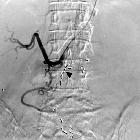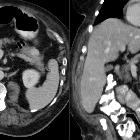Gastrinom

Gastrinomas are the second most common pancreatic endocrine tumor and the most common type in the setting of multiple endocrine neoplasia type I (MEN I).
Epidemiology
Most gastrinomas are sporadic, although some are seen in the setting of multiple endocrine neoplasia type I (MEN I). In general, these present in young adults .
Gastrinomas occur in ~0.1% of patients with peptic ulcer disease.
Clinical presentation
Due to the physiological action of gastrin (>1000 pg/mL), resulting in excessive secretion of acid into the stomach, the initial manifestation is with peptic ulcer disease (PUD) with multiple recurrent and intractable ulcers, often in unusual locations. This constellation of findings due to a gastrinoma is known as Zollinger-Ellison syndrome.
Diarrhea due to the large volume of hydrochloric acid and a direct effect of gastrin on the small bowel is also common.
Pathology
Gastrinomas are usually malignant and as they are frequently multiple and often extrapancreatic (90% located in the gastrinoma triangle). They are more commonly located in the duodenum than in the pancreas.
Tumor size is variable:
- duodenal gastrinomas are usually <1 cm
- pancreatic gastrinomas average 3-4 cm
Markers
- chromogranin A levels may be elevated
Radiographic features
Gastrinomas can be difficult to locate, as such multiphase contrast-enhanced thin slice cross-sectional imaging is ideal. The lesions are often hypervascular, so they may be visible on arterial phase CT and angiography (please refer to the parental article on pancreatic neuroendocrine tumors for further details).
Nuclear medicine
Because gastrinomas often have abundant somatostatin receptors, In-111 octreotide studies have a higher sensitivity for these pancreatic endocrine tumors.
Treatment and prognosis
Hepatic metastases are associated with a poor prognosis, whereas patients with metastases isolated to lymph nodes often have long-term survival.
Siehe auch:
- Magenulkus
- Insulinom
- neuroendokrine Pankreastumoren
- multiple endokrine Neoplasie Typ 1
- Zollinger–Ellison syndrome
- Passaro-Dreieck
und weiter:

 Assoziationen und Differentialdiagnosen zu Gastrinom:
Assoziationen und Differentialdiagnosen zu Gastrinom:



